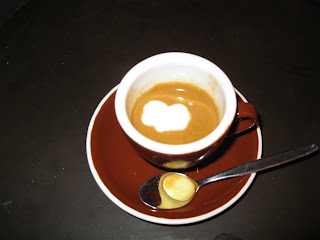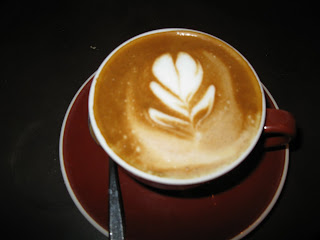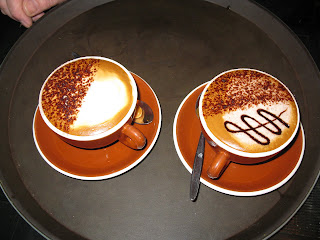
This photo was taken during the first snow of our first winter at the Hilltop, and published in the newspaper, with the title "Iced Coffee?"
Some of my earliest memories are of making coffee…seriously! My mother was NOT a morning person, and this was back in the good old percolator days! (Right, Avon? Feeling ‘Perky’?) As soon as I could reach the kitchen counter, I was in charge of making the percolator coffee before my mom got up. Fill the pot, exactly one scoop of Edward’s into the fiddly (and not kid-friendly) stem and basket contraption and brew! (I won’t get into the other dysfunctionalties of my family here, but children making coffee was a trend!)
In the 70’s, as a college student, I became a fan of the filter, or Melita style drip coffee from the new local coffee roasters that were turning up all over the West Coast. It started a life-time addiction with the flavour of good coffee, not just the caffeine hit I needed every morning. It started (I think, IMHO) with Peet’s in Berkely and then Starbuck’s in Seattle, selling mostly mail-order fine roasted beans. While Peet’s expanded its roasting business, Starbuck’s started doing the ‘fancy’ milky Italian espresso coffees and took the world by storm.
I’ve been extremely fortunate to have travelled a lot, especially in tropical regions (well, you wouldn’t want to scuba dive in Norway would you?) So, I’ve been to coffee plantations in Costa Rica (and drank some great coffee there), had it served French Press style in resorts in Indonesia, had it served with evaporated milk, or straight, in Caribbean Islands (Honduras with milk, Cuba – straight shot), and straight with a bit of cardamom in Egypt. And, although not tropical, I loved my experience with coffees in Italy!!!
So, thinking this would be just a short photo essay about coffee, I can see my passion and knowledge taking this post by the horns! Please bear with me, while I share my experience, knowledge and passion about this delicious, addictive, cherished beverage with you!

Luigi, always the great Italian, helped with coffees during his stay! (Please, excuse the bad hair day!)
Unusually, while NZ stems from a heritage of tea drinkers, coffee is a true passion here. Coffee done properly, that is. No offense, but we just don't do the Grande, half-caf, half-fat, in-a-paper-cup-unless-otherwise-specified coffees here. We treat coffee like steak! You want it hot, I will make it extra hot. You want trim/skinny/no-fat milk, no problem! You'd like it in a take-away cup? I'll hide my grimace, but politely ask "How many sugars?" I'll even do decaf, but not halfway!
All espresso coffees (hopefully!) start with freshly ground, freshly roasted coffee beans. Like grapes for wine, beans vary from region to region, climate to climate and soil to soil. Then, what the roaster does with them varies, from light roast to dark roasts, and then the blends vary. We have an excellent roaster here in Christchurch – C4. They import beans from all around the world and roast and blend them here. We like their blends and style, plus we like the fact that they are consistent in their roasting. This week’s beans should taste the same as last week’s batch. We use Krank Blend for our espressos. On average, we go through about 2 pounds of beans a day – in summer up to 6, in winter, way less. Freshly ground coffee, just dosed
Freshly ground coffee, just dosed
Again, getting the combination of the fineness of the grind and the right amount of compaction, determines the flow rate of the hot water through the coffee. And, just to make things more exciting, believe it or not, the grind can and will change with the weather (humidity), the fullness of the grinders hopper (weight) and the age of the beans. A good barista is constantly monitoring the 'drip' of the extraction and changing the fineness of the grind and the weight of the tamping to suit. The right combination results in the 30 ml of espresso coming through the machine in 20 – 25 seconds. It shouldn’t gush and it shouldn’t drip – it’s what the Italian’s call a ‘mouse tail’. The surface of the extracted coffee is covered by a thin, bubbly, rusty colored layer called the 'crema'. The crema can tell you a lot about the quality of the extraction. Little balck dots = over extracted and it will taste bitter. Pale consistant color = under extracted and it will taste less complex and rich. "Tiger strips rippling through it" = perfect!
There! Your first coffee! A Short Black in NZ (not to be confused with a Tall Black, which is a basketball player), a Doppio (for double) in Italian or usually just an ‘espresso’ in North America.
 A Short Black, in a demi-tasse cup
A Short Black, in a demi-tasse cup
Now, if we ‘mark’ the short black with a little dollop of steamed milk, we now have a ‘Macchiato’, the Italian word for marked!

Once the milk reaches a good temp, turn off the wand and immediately wipe it to avoid having the remaining milk ‘cook’ on to the wand. For the Flat White (not to be confused with an All White, a player on the NZ national men's soccer team), and Latte, we are going to ‘surf’ our milk, by gently swirling it in the jug. This helps keep the airy, frothy milk from separately or rising above the steamed milk underneath. Now, we pour the milk, and when the cup is about half full, gently start shaking or wiggling the spout of the jug. This encourages the frothier milk on the top to pour out, and if you are lucky, creates an impressive pattern! Maybe a cherry, a heart, a flower, or the national symbol of New Zealand, the Silver Fern (which can and should be confused with our women's netball team, the Silver Ferns) So, both of these coffees have the same ‘structure’, they are just in different size cups. The smaller, Flat White and larger Latte, are both 30 mls of espresso topped with about 80% steamed milk and the top layer being ‘flat’ froth. Flat Whites do not seem to be found outside of NZ/Australia, but are probably beginning to turn up in Europe as our ‘baristas’ from down under travel. The Latte, another word for 'Caffe au ‘lait', or coffee with milk, seems to be pretty universal. In NZ, many people serve or offer their Lattes in a glass. I like mine this way, because then I can see the ‘structure’.
 A Cappuccino with chocolate on top. Notice the 'brown hood with the pale face poking through', just like a Capuchin Monk!
A Cappuccino with chocolate on top. Notice the 'brown hood with the pale face poking through', just like a Capuchin Monk!









Hi, Laurel! I didn't realize you had a non-AR blog! Those coffees are absolutely amazing works of art. Wow.
ReplyDeleteHey, Deb! Good to hear from you. I've been using blogger to compose for AR. Haven't really 'promoted' it but might! Just so I can see the likes of you! Love you new blog -- left comments. I looked at FoodieFights, and don't really have time, but it suits you to a T!
ReplyDelete